Chapter 1. Fundamentals of Scientific Inquiry in the Biological Sciences I
1.1
Joan M. Miyazaki
Marvin H. O'Neal III, Ph.D.
Deborah A. Spikes
Undergraduate Biology
Stony Brook University
BIO 204
1.2 Copyright
Copyright © 2015 by Michael J. Cressy, Ph.D., Joan M. Miyazaki, Marvin H. O’Neal III, Ph.D., Deborah A. Spikes, and Undergraduate Biology, Stony Brook University
Copyright © 2015 by Hayden-McNeil, LLC on illustrations provided
Photos provided by Hayden-McNeil, LLC are owned or used under license
All rights reserved.
Permission in writing must be obtained from the publisher before any part of this work may be reproduced or transmitted in any form or by any means, electronic or mechanical, including photocopying and recording, or by any information storage or retrieval system.
ISBN 978-0-7380-7123-7
Hayden-McNeil Publishing
14903 Pilot Drive
Plymouth, MI 48170
www.hmpublishing.com
Acknowledgements
This is our eighth year teaching Fundamentals of Scientific Inquiry in the Biological Sciences. BIO204 & BIO205/207 are sequential laboratories that focus on critical thinking and problem solving instead of memorization and the completion of cookbook activities. We have designed a two-semester curriculum that prepares you for scientific inquiry, experimental design, and use of modern instrumentation.
This new vision of laboratory science education was possible largely because of the dedication and hard work of Kelly O’Donnell, Roberta Harnett, and David Ruggerio in the Fall of 2007. We particularly wish to thank the curriculum committee members: Eugene Katz, John True, Neta Dean, Kate Dilger, and Daniel Apple for their valuable insight into the structure and design of these laboratories. This edition includes labs developed by M. Caitlin Fisher-Reid (Lab 4), Kelly L. O’Donnell (Lab 3), Center for Biomolecular Modeling at the Milwaukee School of Engineering (Lab 10), as well as a modified lab from BioRad Laboratories (Lab 12). They are not responsible for manuscript errors; we assume all responsibility of text and information accuracy.
This manual is not entirely an original text. Rather, it is the compilation of many years of dedicated service from exceptionally talented students, faculty, and staff. We are honored to have worked with them. Leo Shapiro, Paul Wilson, and R. Geeta made contributions to the invertebrates, systematics, and evolution lab exercises. The greenhouse lab would not be possible without Mike Axelrod and John Klump’s rock-solid competence and good humor. This course would not function without the vast talents and efforts of the professional, administrative, and advising staff of Undergraduate Biology.
The teaching philosophy used in this manual was strongly influenced by Bill Dawes, Diane Ebert-May, Jackie Gennon-Brooks, Daniel Apple, Marjorie Kandel, and Barbara Panessa-Warren—over the years they have given us a great deal of creative and helpful advice. The Howard Hughes Medical Institute and the National Academies of Sciences Summer Institute on Undergraduate Education in Biology trained us and supported and encouraged our work to transform undergraduate science education to meet the needs of our students, the future scientists and professionals of the 21st century.
M.J. Cressy, J. M. Miyazaki, D. A. Spikes, and M. H. O’Neal III
Stony Brook University
1.3 General Information
Course Objectives:
This course is designed to be an introduction to your career in the biological sciences and prepare you for upper division biology courses. The most critical aspect of this preparation is to develop scientific thought. In addition, you will be introduced to common laboratory practices and procedures, learn to conduct basic experiments, and practice experimental design using scientific reasoning. This course is divided into 14 labs, each of which falls into one of these categories: Laboratory Skills (Labs 1.5, 2, 5, 7, and 13), Managing Data (Labs 3, 4, and 8), Molecular Techniques (Labs 10–12), Scientific Communication (Labs 1 and 6), and Experimental Design (Lab 9). For each lab there are learning goals and for every activity there are learning objectives. Use these goals and objectives as the backbone of your learning. They should be the target for your preparation, the focus of your progress, and the fundamental components of your preparations for all of assessments within the course, including quizzes, exams, competencies, and assignments.
College laboratories are training grounds for your future work environment, and it takes more than the mastery of a topic to succeed as a professional. You are expected to become a good observer, listener, oral communicator, reader, and writer in the biological sciences. To excel in this course, you will be required to understand and focus on the objectives of a project, think critically and creatively, categorize concepts, make connections, understand and use new terminology, and efficiently manage your time. You will use computers and statistics to collect and analyze data. At times, you will be called upon to be a leader, at other times to be an independent self starter, a team player, or a follower. You will also be required to present your work in both oral and written formats.
Upon completion of BIO204/5, you will have improved these 21st Century skills identified by The National Research Council in a recent report: adaptability, complex communication/social skills, non-routine problem solving, self-management/development, and systems thinking.
1.4 Required Materials
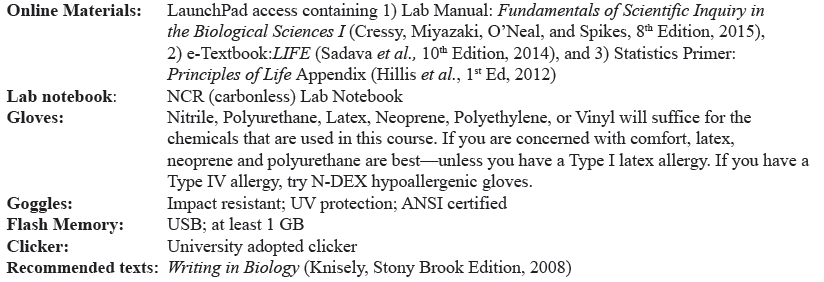
1.5 Use of Animals
Biology is the science of life, and learning biology requires the study of living organisms. In this course, you will be required to handle live plants and animals. You will also be expected to dissect preserved animals in some of the laboratory exercises. In every case, you are expected to handle all living organisms properly based on this manual as well as instructions from your instructor. If you have objections to these requirements, you must meet with Dr. O’Neal or submit in writing your objections within the first two weeks of the course.
1.6 Students with Special Needs
If you have any condition, such as a physical, psychological, medical, or learning disability which will make it difficult for you to carry out the work for this course, or which will require extra time on examinations, please contact the staff in the Disabled Student Services Office (DSS), 128 Educational Communications Center, 632-6748. DSS will review your concerns and determine, with you, what accommodations are necessary and appropriate. Letters of notification should be addressed to Dr. Marvin O’Neal, Z=5110.
1.7 Websites
1.8 Help
An entire team in Undergraduate Biology is here to help you. Follow these procedures to get your questions answered quickly and accurately:
- Ask your instructor for help. ALL instructors are required to hold one office hour each week per section. Feel free to speak with any instructor teaching this course. They are required to help all students taking BIO204. All office hours are open to any student taking BIO204.
- Email faculty for help at our course email: introbiolabs@stonybrook.edu Your email will be answered by one of the following faculty members:

3. Contact staff for specific help (see below):

1.9 Course Administration Roles
- Course Director: Dr. O’Neal is responsible for all course content, policies, and final letter grades.
- Faculty: Joan Miyazaki, Deborah Spikes, and Michael Cressy, PhD are responsible for the biology lab curriculum, the learning facilities including the Biology Learning Labs, and instructors.
- Course Administrators: Lynette Giordano is responsible for add/drop forms, section changes, or other problems relating to course registration. Sue Hayden is responsible for all student absences (see Attendance Policy on slide 10). Diane Pauciullo is responsible for the administration of exams including scantron issues and scheduling make-ups. Course administrators are not responsible for the policies implemented. You may see Dr. O’Neal for difficult issues or problems that remain unresolved.
- Instructors: This is a large course, but you should not feel shy or embarrassed to ask questions during lab or to come to posted office hours. Instructors hold one office hour per section every week in the Biology Learning Center (Room G10 of CMM/BLL); check the schedule posted on the door and on the course website in Blackboard. Dr. O’Neal’s office hours are also posted on the course website or you can visit G05 to schedule an appointment.
1.10 Blackboard
Each student has 2 Blackboard sites for BIO204. Section 204.30 is used for communication between faculty and all students, which includes admistrative changes, course updates and exam grades. The individual lab sections each have their own Blackboard site (L##) and is used for section specific communication between instructor and the students in that lab section, including e-portfolio uploads, discussion board posts, quiz grades, group collaboration, and section emails. Check both Blackboard sites weekly.
1.11 Laboratory Etiquette

- Do not bring food or drink into the labs. Students who choose to eat and drink in lab will be asked to leave and will receive a zero for their Lab Performance score.
- Computers are to be used for lab activities only. Students are not allowed to download programs, change shortcuts, or alter any settings on the lab computers. Please remember to log off of all lab computers and do not share accounts or passwords with fellow students. Students are welcomed to bring their own laptops or tablets to lab if they are used for professional activities. Unless asked to do so by your instructor, do not engage in any social media, video calls, games, or activities unrelated to laboratory.
- Full lab participation is expected. Your lab performance grade is based on participation during experiments and data collection, group involvement, inquiry, cooperation, and techniques. Tardiness will adversely affect your grade. Zeros are given for unexcused absences. Repeated absences (3 or more) will result in failure of the course.
- Electronic communication devices, including cellular phones and tablets, should be used during laboratory to take pictures, document experiments or foster collaboration. Please do not make personal calls or text during laboratory unless it directly applies to the assigned activity.
- View online lectures and demonstrations to understand the concepts and techniques before each lab. Students who have performed well in this lab “actively” view the online material by taking clear and organized notes and recording any questions that they have about course material. All questions should be brought to the attention of your instructor prior to lab.
- Stay Ahead and if you fall behind, do not wait to catch up. This course covers too much information to learn by cramming. Online lectures are always available to you; there is no excuse for missing lecture information. If you run into personal problems that make it difficult to keep up, see a faculty member as soon as possible to work something out.
- Monitor your grades and progress. If you are not getting the grades you want, see your instructor immediately, and a faculty member if necessary, to work out a plan to improve your performance. Do not walk into G05 at the end of the semester requesting that your grade be changed because you need a better grade to achieve your career goals. At this point, it will be too late.
1.12 Attendance Policy
Lab attendance is required. You are expected to attend and participate in every lab for the full period. If you miss 3 normally scheduled labs, for any reason (excused or unexcused), you will automatically fail this course. When in lab, you should be working. Lab performance (professionalism, technical skills, and analytical skills) are a part of your grade. Tardiness is not acceptable and incurs a performance grade penalty. Quizzes are given at the beginning of lab and can not be made-up if you are tardy without an excuse. In general—no make-up quizzes will be given.
Excused Absences: An unavoidable absence from lab which is due to sudden illness or a death in the family may be excused. Documentation must be submitted to the Course Administrator, Lynette Giordano (Office: 110 CMM/BLL, 632-8530). Students are only excused from the performance and quiz component for the week of the absence. Excused students are still responsible for all written work, which are due within one week of returning to lab (or the next lab session). There are no make-up quizzes. The quiz grade from the excused absence will be calculated as an averaged percent of the remaining quizzes (all of your other quizzes will be averaged and this average will be used as a substitute). Exams and practicals must be taken at regularly scheduled times. Requests to make up an exam should be submitted, in writing, to the Course Director and should be accompanied by an excused absence and written documentation. Permission to make up exams and practicals will be decided on a case by case basis.
Make-up Laboratories: There are no make-up labs. In rare circumstances, you may be permitted to attend another lab section within the regular lab schedule “if” space is available, you bring in a valid excuse, AND are approved by the Course Administrator, Lynette Giordano (Office: 110 CMM/BLL, 632-8530). A “Bio Student Absence Form” must be completed, signed by the Course Administrator, and presented to the Lab Instructor of the make-up lab section that you attend. Making up a laboratory does not negate an unexcused absence.
Note
If you have an official, pre-scheduled university event such as an athletic competition or an exam conflict in another class, then you should schedule make-up laboratories or exams by the second week of classes. Last minute requests will not be honored.
Unexcused Absences: Zeros will be given for all lab work including quizzes, lab performance and in-class activities if you are absent (unexcused). Work that is missed due to lateness will not be excused. Lab work that is due on the day of an unexcused absence should be submitted electronically by the beginning of lab to be accepted as “on time.”
Calculating Penalties for Late Work: For assignments to be accepted on time, they must be submitted by the beginning of lab, before the quiz, on the due date. Late assignments will be penalized 10% of the total point value per day; except for late work due to an excused absence (see above). For example, an assignment worth 100 points that is one day late will receive a grade no higher than 90, 2 days late, no higher than 80, etc. Assignments are graded based on a rubric and the percent score is multiplied by the late penalty score. If you received 78% based on the rubric and were two days late, your final grade would be 62.4% (0.78 * 80). No assignments will be accepted more than 7 days after the due date.
1.13 Academic Integrity
Academic honesty and integrity are fundamental to all aspects of academic and scholarly work. Therefore, consistent with University policy, we view any form of academic dishonesty with utmost seriousness and will take the necessary steps to protect the academic integrity of this course.
- Definition: “Academic dishonesty includes any act that is designed to obtain fraudulently, either for oneself or for someone else, academic credit, grades, or other recognition that is not properly earned or that adversely affects another’s grade.” The following represents examples of this but does not constitute an exhaustive list:
- Cheating on exams or assignments by the use of books, electronic devices, notes, or other aids when these are not permitted including collusion or copying from another student.
- Submitting the same paper in more than one course or repeatedly within the same course without permission of the instructors.
- Plagiarizing: copying someone else’s writing or paraphrasing it too closely, even if it constitutes only some of your written assignment.
- Falsifying documents or records related to credit, grades, status (e.g., adds and drops, P/NC grading), or other academic matters.
- Altering an exam or paper after it has been graded in order to request a grade change.
- Stealing, concealing, destroying, or inappropriately modifying classroom or other instructional material, such as posted exams, laboratory supplies, or computer programs.
- Preventing relevant material from being subjected to academic evaluation.
- Action: The strongest action allowed by University guidelines will be followed for each incident. Without exception, all incidents will be submitted in writing to the University Academic Judiciary Committee.
- Result: All students found guilty of academic dishonesty are required to take the University’s course on academic integrity (the “Q” course); however, additional penalties may also be levied. These penalties could range from receiving a “0” on an assignment or exam, failure of a course, and possibly suspension or expulsion from the University. Once reported, students are subject to the ruling and findings of the Academic Judiciary Committee. Information about the procedures for hearings and other functions (including appeals) can be found on the website referenced below as well as in the Office of Undergraduate Academic Affairs (www.stonybrook.edu/uaa/).
1.14 Student Grades
Quizzes (10%) are given at the beginning of each laboratory utilizing the university-adopted clicker to test if you are prepared for lab. Concepts are used from 1) LaunchPad, 2) the online lecture (vodcast), and 3) lab manual. You are encouraged to take notes in your lab notebook, which can be used (if hand-written or permanently placed in your lab notebook) during quizzes. Each of the 11 quizzes is worth 10 points and includes 5 questions that are multiple choice. The lowest quiz grade is dropped. No quiz for Lab 6 or 13.
Lab Performance (5%) is based on your group work (see APPENDIX A) during experiments, data collection, group discussion, and scientific inquiry. Full participation is expected. All students begin the semester with a perfect 50 point score and receive reductions for tardiness (–2; if you arrive to lab after the quiz has ended) or lack of participation (–2; not prepared for lab, not performing a group role, regularly leaving during lab, missing a large percentage of lab, etc.). Each week’s deductions will be posted in your section’s Blackboard site (L##) by your instructor.
Exams (35%) include the Competency, Midterm, and Final. NO ONE WILL BE ADMITTED LATE TOTHESE EXAMS. Because of the size of this course, we are forced to adhere strictly to this policy. Even if you have a valid excuse, you will not be allowed to take exams if you come late. If you have a valid, documented excuse, see Lynette Giordano immediately. After the exams, if you wish to protest a question or answer, submit your reasoned argument to introbiolabs@stonybrook.edu on the next business day following the posting of the answer key. The Competency Exam tests practical skills using laboratory instrumentation. All questions are posted prior to the exam. Successfully completing practice sessions (50 pts. on the Mastery Sheet) in the Biology Learning Center will prepare students for the exam (50 pts.). The Midterm and Final Exams are multiple choice and/or short answer exams designed to measure your progress in the course based on the learning objectives at the beginning of each lab activity. Exams will test your knowledge of content, skills, and critical thinking in the previous labs. You will be required to both learn and apply concepts from this course as well as the prerequisites including General Chemistry and basic computational Mathematics.
Scientific Literature Project (15%) is completed in 7 weeks and is designed to teach you how to read primary scientific literature. This project includes 5 major steps: 1) applying a reading strategy, 2) completing a worksheet, 3) actively watching a scientist’s vodcast, 4) presenting a poster summarizing your assigned article to your peers, and 5) writing a summary essay. You will receive feedback on your worksheet (25 pts.), poster (75 pts.) and essay (50 pts.). Because 24 different articles are assigned to each section, your instructor will not grade all parts of this project; instead, 1-2 instructor(s) teaching BIO204 will be assigned each article and grade the accuracy of your poster and essay. A list of the 24 articles and instructor “experts” will be posted on Bb section 204.30. It is important that you meet with the expert instructor if you have any questions about your assigned article. SPK (Speak Effectively before an Audience): The poster presentation for this project, coupled with the presentation portion of Lab 9 and the GMO Debate are the three assessments used to satisfy the SPK category of Stony Brook’s General Education Curriculum.
Digital Notebook (15%) is an electronic record of your work during laboratories and will be graded twice during the semester (mid = 50 pts. and end = 100 pts.). You will be graded based on a uniform scale across all sections (see below). Not submitting assignments results in “0” points awarded.
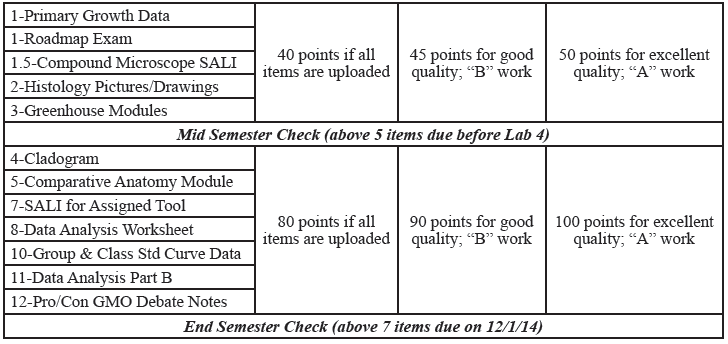
Lab Report (20%) is based on a structured brief report from Lab 1 and your own Isopod Experiment to be designed and conducted during Labs 8 and 9. These reports should be typed and submitted to Blackboard’s SafeAssign. Instructors will utilize rubrics for more uniform grading across sections which will be posted on Blackboard. Your reports should be structured based on Chapters 4–6 of the SBU edition of Knisely’s “A Student Handbook for Writing in Biology” which can be found in all labs, including the Biology Learning Center. These 2 assignments are designed to teach you how to write a lab report. We will reward learning and improvement: if your % grade on Lab 9 is higher than Lab 1, then the Lab 9 grade will count for all 200 points.
The following is a summary of the above mentioned components totalling 1000 points:
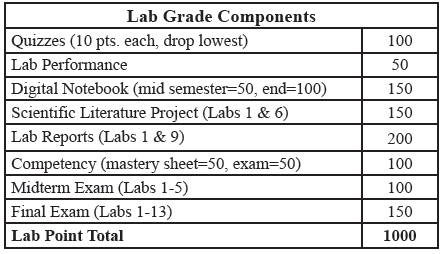
Course Schedule
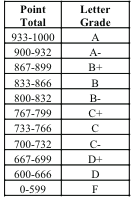
Letter Grades are assigned following a meeting between all of the instructors and faculty at the end of the semester. Letter grades are based on your final point total. The table on the right will help you determine the MINIMUM letter grade that you will receive based on accumulated points. However, we typically curve a section based on its performance relative to other sections and to the overall averages in each category for the entire class. Therefore, your letter grade may be higher than this scale (for example, in BIO 204 fall 2008, a score of 875- 1000 received an “A” and the “F” range was 0–499 points). Historically, the average letter grade in this course has been approximately a C+. While course grades are commonly curved up, they are never curved down. If every student accumulates at least 933 points by the end of the semester, then everyone will receive an “A”. It is therefore possible for all students within a section to receive an “A” (24/24), although historically the highest number has been 17/22. If Extra Credit is given, then the letter grade will still be calculated based on the 1000 point scale and not a percent score, even if the total exceeds 1000 points.
Use the following table to monitor your progress in BIO 204:
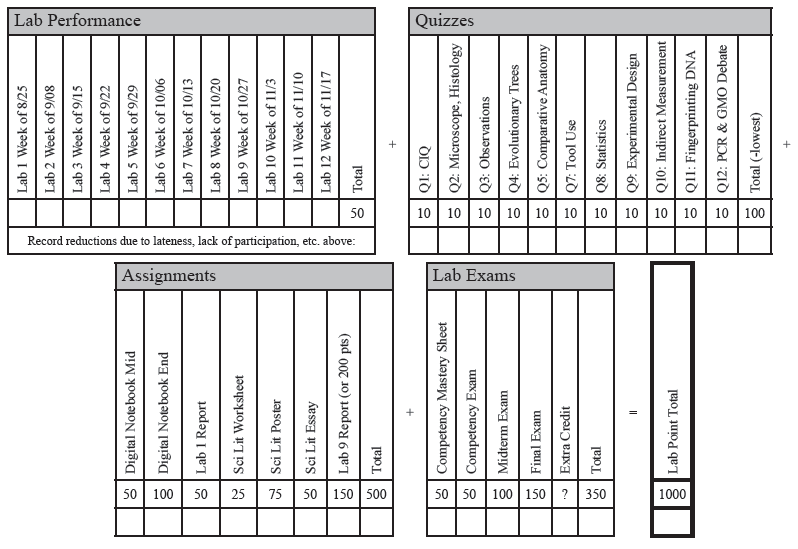
1.15 Laboratory Notebook
Track the progress of your projects using a notebook with NCR paper. Research notes, descriptions, data collection, ideas, and reflections, are fundamental to science. You will be asked to turn in the copied page of these notes at the end of each lab, so keep them neat and up to date. These can be used for weekly quizzes.
Expected Content: Notebooks are records of work accomplished in lab and serve as future reference for protocols used; details of instrumentation use; roles and credit for work done by group members.
- Table of Contents — first two pages
- Your name, group members, group roles and date — on each page
- Numbers — Data measurements, counts, etc. in data tables and graphs
- Visuals — Sketches, figures
- Text — Write purpose statements, descriptions, and legends. Insights described, quality of questions, additional hypotheses, evidence of progress are indicators of critical thinking and depth of understanding.
- Organization and Clarity — Legibility and neatness as needed to retrieve information efficiently
- Pre-lab content — Vodcast and reading notes with answers to discussion questions. These may not be handed in as typed pages. Lab notebooks can be used during Quizzes.
- Academic Integrity — Copying another student’s lab notebook is not acceptable, unless they are in your group and the data were collected as a group. For example, copying raw data from your lab partner’s notebook is typical practice in research labs and is OK in this course. However, copying answers to discussion questions or notes from vodcasts is NOT acceptable.
Grading Standards for Lab Notebook Evaluations:
- Excellent — Notes are thorough and informative. Measurements recorded in tables (with units), clear and easy to follow, excellent observations, labeled graphs and clear figures with legends, group contributions (roles) included. Insights into understanding or future investigations demonstrate critical thinking and depth of understanding. Details of essential information included (e.g., locality for field work). Individual contributions to group report: all individuals contributed according to their roles. SII for group and lab activities are clearly recorded. Contributions, strengths, areas for improvement and insights into team contribution and lab activities.
- Good — Notes are adequate reference for future use. Notes are similar in most ways to the excellent category above, graphs and figures OK, notes acceptable, details OK, readable, neat enough. Some important information is missing or hard to locate. SIIs are adequate.
- Needs Improvement — Most important information recorded, but overall notes, graphs and figures are lacking in detail, clarity and organization making it difficult to follow this record of lab activities. SIIs are weak or superficial.
- Failing — Notes are minimal and uninformative—not useable as a reference for future investigations. Sloppy or wasted space. Important information such as name, date, team members, missing. Sketches have no labels or references. SII weak or missing.
Team Roles: Rotate weekly—While all members are responsible for carrying out lab activities, each role carries specific responsibilities. Refer to Appendix A for complete descriptions for each team role for a group of 4 students: leader, technician, analyst, and recorder (in groups of 3 students, the leader is also the analyst).
1.16 Habits of Effective Students
written by Sherryl Broverman

Success is a matter of choice. While obviously not all are born with equal abilities, educators know that those students who achieve high grades do so mostly because of their learning habits. This includes attending all classes and taking good notes, but it also goes much deeper than this. In fact, there is a culture of learning, and, like all cultures, it can be explored and assimilated by those who value it.
Taking Responsibility
The number one attribute of a successful student is taking personal responsibility for your own education. You must realize that you have more to benefit than anyone else does by taking control of your undergraduate experience. This means:
- Obtaining and reading the syllabus
- Doing the readings prior to class
- Viewing all lectures
- Actively listening during lecture
- Re-reading or rewriting your notes in the evening
- Preparing for lab
- Understanding lab objectives
- Fully participating during lab
- Following up on all lab assignments
This sounds simple and self-evident, but many students set themselves up for failure by not doing even these basic things. Clearly all these things take time and some sacrifice of social activities. However, every learner must do a personal cost-benefit analysis of how they spend their time and what they hope to achieve from their education. Successful students realize that the payoffs can be enormous. Another aspect of taking personal responsibility is realizing that learning does not occur in a vacuum. This means identifying all the resources available to help you learn and achieve success—and using them! The number one resource around you is people: classmates, teaching assistants and faculty. Your peers are wonderful, and often under-utilized, assets. One hundred people listening to the same lecture often write down different things. If you compare notes with each other (e.g., identifying major concepts and filling in gaps), then you all will benefit. For those questions not resolved by discussions with peers, seek out an instructor, whether graduate student or faculty. Besides it being their job, the majority of people involved in education LIKE to teach and look forward to assisting others in learning. After reviewing your notes, bring them to office hours with questions. Traditionally, students who interact more with instructors/faculty do better on exams.
There are, of course, other resources available to students besides people. The primary one should be this course’s accompanying texts. If an unknown word or term is used during lecture, look it up in the index or examine the definition in the glossary. A capable student also identifies related resources whether they are library references, CD-ROMs, or web sites. A caution about web sites: not all information on web sites has been through the critical review process which is so essential to good science. There is a great deal of misinformation on the web, so beware!
Goal Setting
Another important feature of a successful student is they know how to set personal goals and how to develop strategies for reaching them. The first step in doing this is to set specific goals rather than vague ones; i.e., instead of saying, “I will study tonight”, say “I will read a chapter in chemistry and do ten math problems tonight.” It is also useful to take a long term goal (“I want to get into graduate school”) and break it down into concrete short term goals (“I want to get an A or B in biology, so I will do the reading and homework assignments before each class.”). Goals differ from wishes in that they are attainable by personal action. The best goals define the action needed to accomplish them. Most importantly, goals should be realistic and self-chosen, which means some self-awareness is necessary to create them. Only with an attainable and personally valuable goal will you avoid frustration and disappointment.
By following the guidelines presented here you can begin to develop a culture of learning. By doing so, you won’t just enhance your performance as an undergraduate, the majority of the skills listed above (taking personal responsibility, budgeting time, identifying resources, setting goals, etc.) will assist you in achieving success in all walks of life.
1.17 The Importance of Collaboration in Science
Science has always been a cooperative discipline; each new piece of knowledge must be created from the existing knowledge and will in turn lead to even more breakthroughs. Education, on the other hand, has traditionally been something you do on your own: attending lecture, taking notes, studying for tests, sometimes working with a partner in a lab. The skill of cooperating with a team in an organized way to achieve a common goal is fast becoming commonplace in all areas of life, including business and industry, health care, public service, government, and especially education.
Undergraduate students of biology have been discovering the many benefits of teamwork. Collaborating with others allows each of you to accomplish more work, and a higher quality of work, in a shorter period of time. Teamwork allows the development of interpersonal skills that will benefit you in all aspects of your life. Also individuals in a team benefit by teaching others new skills, learning to negotiate, exercising leadership, working with diversity, and benefiting from the knowledge and skills of others. Students who have completed a semester of group work often say they learned more and learned faster by discussing what they are learning with teammates. It is for reasons such as these that the activities in this course have been designed to incorporate the teamwork process.
As you will realize from your experiences in this course, an effective teamwork process involves a great deal more than simply putting people together in a group with a task to work on. A very valuable way of approaching problems in a group is to have each member of the group perform a defined role. In Appendix A are roles that can help build a strong team and allow you to complete high quality work in a shorter period of time.